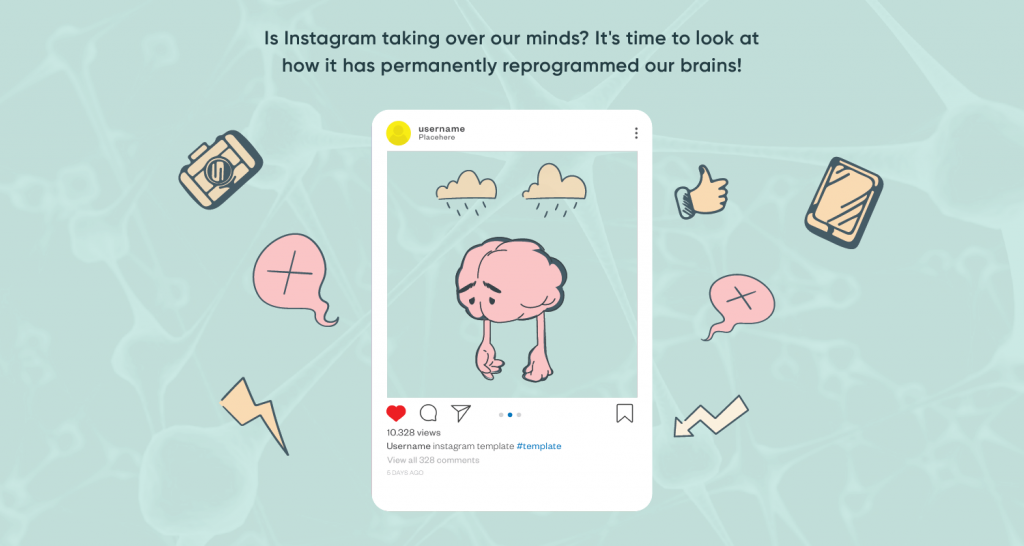Instagram has become the go-to platform for fame. Instagram’s world is comparable to show business, where everyone is attractive and everything is wonderful and shiny. But is Instagram as great as it seems?
Perhaps not. Social media by its very nature reinforces. It stimulates the reward centre of the brain by releasing dopamine, a “feel-good chemical” linked to pleasurable activities like eating, smoking, and engaging in social interactions. They do this on purpose to foster an environment that is addicting and has been associated with higher levels of stress, despair, and even physical sickness. There is a lot to take care of when it comes to Impact of Instagram on Mental health.
The Pew Research Center found that 69 percent of adults and 81 percent of teens in the United States regularly use social networking sites. This raises the possibility that a sizable section of the populace may experience anxiety or despair.
Despite the fact that repeated use can make one mentally sick, why do people keep coming back for more? No one can predict how many “likes” a photo will get, who will “like” it, or when they will get them. The prospect of a desired goal and the uncertainty of the outcome can keep visitors engaged with it.”
The Royal College of Psychiatrists published a study that specifically addressed that issue and demanded that social media companies disclose information on the app usage patterns of young people. There is a depressing explanation for this. In the United Kingdom, nonsuicidal self-harm has risen over the previous decade, and four school-aged youngsters commit themselves each week on average. There is a direct correlation between this and the widespread usage of social media among young people.
When it comes to young people’s emotional well-being, social media is by far the worst culprit. Whether or not we feel “at risk,” do we know for sure that we are safe from its effects? After all, if we spend hours each day mindlessly scrolling, how much do we really know about what happens within our brains? Is scrolling through Instagram bad for mental health
Expert neuroscientists are looking into the possibility that prolonged exposure to these devices could have a negative impact on brain function and, by extension, human behaviour and mental health. In the event that Instagram is brainwashing us, we risk becoming true app-dependent robots.
It’s time to start waking up to the possible risks it poses, so I hope your phones are still down and you aren’t checking out your friends’ latest Instagram stories.
Instagram Algorithm Slavery
Nearly every time we check our phones, we see another headline warning us that Instagram is ruining our minds and making us into mindless app addicts. The question is, though, whether or not our frequent use is actually harmful.
Let’s take a closer look at this, especially for those who are not familiar with the algorithm, and how the Instagram algorithm works.
What exactly is Instagram’s algorithm?
An algorithm is a set of guidelines that determines how content is ranked on Instagram. It determines which posts appear on users’ feeds, Explore, Reels, hashtag pages, etc., and in what sequence.
Every piece of material that is shared on Instagram is examined by the platform’s algorithm. It takes into account interaction metrics, hashtags, and metadata (such as image descriptions and alt text). This data is used to determine how to distribute content so that people can easily find the content they are most interested in.
To put it simply, the Instagram algorithm uses data about content (posts, Stories, Reels) and data about users (interests, platform activity) to match the right material with the right individuals.
This Internet-based algorithm also considers how you interact with other users, in addition to how you engage with material. Do you have a fan who seeks you out specifically? How often do you interact with one another? How frequently do you get mentioned in social media posts? When you post a new video to Instagram, the app is more likely to notify your closest friends and most devoted fans immediately.
It’s possible that Reels and Explore will recommend videos from channels you’re unfamiliar with… However, Instagram also takes into account if you have previously interacted with them in any manner.It also monitors user affinity, which is just another way of stating “what you like.” Instagram makes an effort to show you stuff that is connected to a reel or post that you have already liked or engaged with in some other way.
How does AI discover the subject of a video?.. Good question!
With the use of hashtags for your Instagram Reels, as well as close inspection of the images and sounds within them.
For Instance: Watching videos of Paris-based influencers, Dan Levy and his character David Rose, or a singing cockatiel parrot!
For this reason, the system gives new content a higher weight than archival Reels. The algorithm gods know that people are always interested in what’s fresh.
Who is writing the algorithm code? Ask yourself this: do you control the algorithm, or does it control you?
How does it function?
The algorithm is designed to maximise clicks and engagement. Consequently, an excessive amount of anything is bad, as is an excessive amount of controversy surrounding any given topic. Anything distinctive is undesirable.
What’s wrong with algorithms, exactly?
It destroys self-esteem. It traps people in their own opinions. It encourages averageness. That system tends to reward conformity to the norm or the herd mentality.
Cognitive Processing Delay
The first thing you probably already know is that Instagram raises dopamine levels, which is the brain chemical responsible for happiness. Great! Oh, but that’s not so wonderful because the constant surge of dopamine from gains in popularity and related metrics keeps us hooked. Additionally, spending an increasing amount of time on Instagram may harm your brain.
Perhaps the most worrisome discovery was the correlation between time spent on social media and “age-related cognitive decline” in the brain. Yes, it seems like we might need something similar to Azelaic serum that slows the ageing process in our brains. Because we are not using our brains sufficiently, leading to a decline in cognitive function.
As I’m writing this, I’m thinking about a poem by Karl Kristian Flores. A poem titled “Dopamine”. It addresses the negative effects of social media and the disastrous evolutionary consequences of platforms like Instagram, Facebook, and Tik Tok.
The Infinite Scroll ~ Too Hard to compete with
According to eminent neurologist Baroness Susan Greenfield. Social media offers experience rather than cognition, These quick-moving visuals are dictating how the brain functions; we are no longer thinking, only responding. It has to do with the stimulation these apps provide us with through their sensory potency. We can process data more quickly, but we don’t necessarily understand it any better.
Through scrolling feeds and continuous notifications, we are consuming too much surface-level information at once. Ironically, having too much knowledge prevents it from entering our minds. What’s the fix? get bored. We all no longer geting bored since we are constantly entertained by our mobile phones.
Baroness Greenfield says that being bored is essential for our mental growth because it forces us to spend time alone with our thoughts. Using our imagination is crucial for cognitive development. “We must create an internal mental process that we can control. These cognitive processes are currently being driven by social media and its Internet based algorithm, which can have a significant psychological impact.
FOMO Has Become a Popular Meme
Let’s not forget that these brain processes were considered when social media was being developed. Instagram enhances our dopamine levels on purpose. We continue to use the software since it works as intended. Social media was created to satisfy fundamental human wants including conceit, social connection, and approval.
But if social media was designed to meet these requirements, it has also amplified the worst in peoplecyber bullying, and bad ideas become trolls and the human psyche (Fear of Missing Out, Social Anxiety, and Upward Comparison are all magnified on Instagram). This detrimental aggravation is what is destroying our mental health and is the reason Instagram was named the social media network that harms young people the most in a 2017 study.
Before the advent of social media, we may worry that our friends were getting together without us, or that they didn’t like us. Nowadays, social media offers a measure of our popularity and evidence that our friends are socializing without us. And for a young, still-forming mind, that can be too much.

Is this all there is to life capturing the perfect shot for Instagram?
To put it another way, Instagram subtly rewires our behaviour. Instagram’s “influence” is having an impact not only on our minds but also on our entire societal structure. Is this all there is to life, capturing the perfect shot for Instagram?
Tristan Harris, the founder of the Center for Humane Technology, a former Google employee, believes that this social media is “not connected with the structures of reality” and therefore harmful. He is on a personal crusade to purify the internet industry, and his group is advocating for strict rules to govern platforms like Instagram. He desires to realign technology in the best interests of humanity.
To what extent, then, do we face certain destruction? Are our minds ruined?
It goes without saying that there is also a clear and growing opposition to social media. Tristan’s organisation is still in its early stages, and BJ Fogg, the professor who educated him in the same Stanford Persuasive Technology Lab, tweeted last year that a “post digital” movement will emerge in 2020. Our society will eventually come to view being glued to a smartphone as an indicator of social depravity on par with smoking.
55% of people between the ages of 15 and 37 prefer to avoid “visual stimulation,” so it’s no surprise that many members of Generation Z are migrating away from traditional social networking apps and toward “sound stimuli,” such as podcasts and audiobooks.
Tech companies and social media companies are beginning to address these challenges as well. Instagram has made progress in terms of safety, including the implementation of the removal of “likes” and in-app support for those who struggle with mental health issues. Additionally, Google launched a project called “Digital Wellbeing” that resulted in the creation of smartphone envelopes early this year that forbid the use of the device for anything other than making calls.
Until there is complete oversight of the social media industry, self-regulation is essential. Leave your phone at home, refrain from using it while awaiting the bus, and use that extra time doing something that will exercise your brain, like reading a book. Digital burnout, or the worry, tiredness, and lethargy brought on by too much time spent on digital gadgets, is a condition that is becoming more and more prevalent.
The risk of burning out increases as technology makes us more connected and as more people rely on computers, tablets, and cellphones for work or study. Learn about the links between screen time and mental health and how to spot digital burnout’s warning signals. Or, maybe we should just give in to our boredom. We can reclaim our cognition and bring our minds back into harmony.
It would be preferable, in my opinion, to take a break from compulsively scrolling through these apps. That does not imply that we should switch to other applications! We may all benefit from periodic breaks from our technological dependence. Maybe it’s good to take a break from technology every once in a while and do things like reading a book, talking to people in person, and exploring the great outdoors. Those of you who work the standard 9 to 5 schedule may find this hard to believe. However, for at least one hour each day, we need to limit our screen time. Let’s take small steps toward achieving physical and mental wellness.







